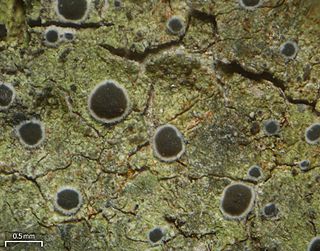Physcidia is a genus of lichen-forming fungi in the family Ramalinaceae. The genus was circumscribed in 1862 by American lichenologist Edward Tuckerman.

Byssoloma is a genus of leaf-dwelling lichens in the family Pilocarpaceae.
Cratiria is a genus of lichen-forming fungi in the family Caliciaceae. The genus has a widespread distribution, especially in tropical regions, and contains about 20 species. The genus was circumscribed by Austrian lichenologist Bernhard Marbach in 2000, with Cratiria lauri-cassiae assigned as the type species.

Gassicurtia is a genus of lichenized fungi in the family Caliciaceae.

Astrothelium is a large genus of corticolous (bark-dwelling) lichens in the family Trypetheliaceae. The genus is characterized by a corticate thallus and diverse ascomata structures, which can be simple, aggregated, or forming pseudostromata. Astrothelium is also notable for the carbonized walls of its ascomata, the so-called textura intricata arrangement of cells in these walls, and various forms of distoseptate, transparent spores.
Polymeridium is a genus of lichen-forming fungi in the family Trypetheliaceae. Species in the genus are corticolous (bark-dwelling) and typically occur in tropical areas.
André Aptroot is a Dutch mycologist and lichenologist. His primary research focus is on biodiversity, particularly tropical lichens, encompassing systematics, floristic surveys, and taxonomic reviews. A prolific researcher, he has published more than 500 scientific papers and described hundreds of new fungal and lichen species.

Malmideaceae is a family of crustose and corticolous lichens in the order Lecanorales. It contains eight genera and about 70 species.
Baculifera is a genus of lichens in the family Caliciaceae. It was circumscribed in 2000 by Bernhard Marbach and Klaus Kalb. Species in this genus are characterized by having bacilliform conidia typically measuring 8–11 μm long, and a non-inspersed hymenium. The genus is roughly similar in morphology to Buellia.
Sculptolumina is a genus of corticolous lichens in the family Caliciaceae. The genus was circumscribed by Bernhard Marbach in 2000, with Sculptolumina japonica designated as the type species.
Endohyalina is a genus of 10 species of corticolous lichens in the family Caliciaceae. The genus was circumscribed by Bernhard Marbach in 2000, with Endohyalina rappii designated as the type species.
Chrismofulvea is a genus of lichen-forming fungi in the family Caliciaceae. The genus was circumscribed by Austrian lichenologist Bernhard Marbach in 2000, with Chrismofulvea dialyta assigned as the type species. It was one of several segregate genera proposed by Marbach in his 2000 revision of American species of Buellia.
Fluctua is a lichen genus in the family Caliciaceae. It is monotypic, containing the single crustose lichen species Fluctua megapotamica. The genus was circumscribed by Austrian lichenologist Bernhard Marbach in 2000. It was one of several segregate genera proposed by Marbach in his 2000 revision of American species of Buellia. The lichen is found in Brazil and Uruguay.
Eugeniella is a genus of mostly leaf-dwelling (foliicolous) lichens in the family Pilocarpaceae. It contains 13 species. The genus was circumscribed in 2008 by lichenologists Robert Lücking, Emmanuël Sérusiaux, and Klaus Kalb, with Eugeniella psychotriae assigned as the type species. This lichen was originally called Patellaria psychotriae by Johannes Müller Argoviensis in 1881. The seven species that were initially included in the genus had previously been placed in the genera Bacidia and Byssoloma. Several newly identified species from Australasia and Central and South America were later added. Most of the species grow on leaves, although four of the Australasian species grow on bark.

Ciposia is a single-species fungal genus in the family Caliciaceae. Circumscribed by Bernhard Marbach in 2000, it contains the species Ciposia wheeleri, a corticolous (bark-dwelling) and crustose lichen. This species was originally classified in genus Buellia by Richard Harris in 1988.
Hafellia alisioae is a rare species of corticolous (bark-dwelling), crustose lichen in the family Caliciaceae. Found in the Canary Islands, it was formally described as a new species in 2003 by Javier Etayo and Bernhard Marbach. The species epithet alisioae is derived from alisios, the Spanish word for the moisture-laden Atlantic winds that blow from the northeast, bringing high humidity and rain to exposed coasts with biodiverse lichen growth. Mireia Giralt and Pieter P.G. van den Boom proposed to transfer the taxon to the genus Buellia in 2011.





